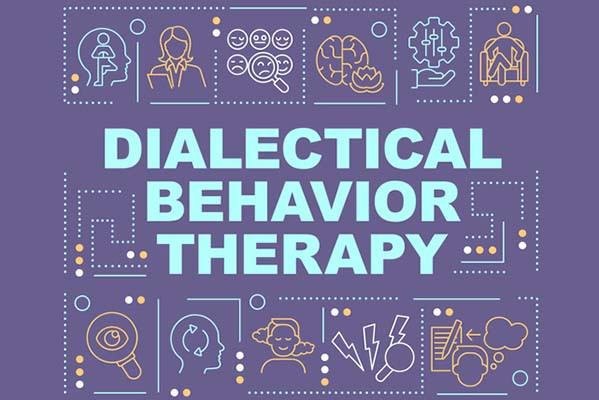
Feeling sad, anxious, or angry at times is a normal part of the human experience. But do you — or someone you’re close to — seem to experience these and similar emotions more quickly, more frequently, and more intensely than most people?
This problem, known as emotional dysregulation, is a hallmark of many mental health conditions, but especially borderline personality disorder. The most effective treatment for borderline personality disorder is dialectical behavior therapy (DBT), which has also been shown to help people experiencing other issues. What is DBT, who might benefit from this form of therapy, and how is it applied?
What is DBT?
DBT focuses on teaching people skills to manage intense emotions, cope with challenging situations, and improve their relationships. It encourages people to learn and use mindfulness training in practical ways.
During individual and group sessions, therapists encourage a nonjudgmental attitude and emphasize acceptance, compassion, and other aspects of mindfulness.
Who may benefit from DBT?
DBT has a proven track record for addressing the most debilitating symptoms of borderline personality disorder: self-injury and suicide threats or attempts. It is now also used to treat depression, post-traumatic stress disorder, eating disorders, and substance use disorders.
In fact, the cornerstone of DBT — the skills training — can help anyone navigate emotionally charged situations with more ease.
How can mindfulness change how people experience strong emotions?
Many people in therapy have very strong emotions that lead to negative thoughts, says Dr. Blaise Aguirre, a psychiatrist who founded the 3 East Dialectic Behavior Therapy Continuum at Harvard-affiliated McLean Hospital. “They say things like, ‘I’m stupid,’ or ‘I can’t control my anger,’ or ‘No one will ever love me,'” he says.
The mindfulness aspect of DBT teaches people to pay careful attention to the nature, quality, and volume of their thoughts. The idea is to observe these thoughts as separate from yourself without identifying with their meaning. This is the first step to addressing the impact of those thoughts, Dr. Aguirre explains.
How does DBT differ from cognitive behavioral therapy?
DBT is derived from cognitive behavioral therapy (CBT). CBT assumes that certain negative thoughts (cognitions) are distortions, and if you learn how to swap those distorted thoughts with more productive ones, you’ll be less depressed or anxious.
“But for someone with very deep emotions and convictions, telling them that their thoughts and feelings are somehow ‘wrong’ feels very invalidating,” says Dr. Aguirre. A DBT-trained therapist would instead acknowledge that the person’s thoughts make sense, given who they are and their experiences. This practice, known as validation, is a central tenet of DBT. It’s key to know that you can validate a person’s thoughts even if you don’t agree with them.
That concept touches on the core of DBT — the dialectical part. It refers to the idea that two opposite things can be true at the same time. Rather than viewing things in extremes of black and white, DBT encourages people to recognize there’s more than one way to view a situation and to try to “walk the middle path.” A classic DBT mantra is “I’m doing the best that I can in this moment, and I want to and can do better.”
What other skills does DBT rely on?
In addition to mindfulness, DBT teaches three other main skills:
- Distress tolerance is the ability to manage emotional distress in the moment, using techniques such as distraction.
- Emotion regulation involves recognizing, accepting, and managing intense emotions.
- Interpersonal effectiveness focuses on improving communication with other people to strengthen relationships and improve your self-esteem.
What does DBT entail?
Ideally, DBT includes one-on-one sessions with a therapist (who is also available between sessions for phone or text coaching). The one-on-one sessions are combined with weekly group sessions led by a therapist who teaches the specific, interconnected skills and gives homework that helps to reinforce the skills. Participants are encouraged to keep a daily diary to track their emotions, behaviors, reactions, and examples of how they’re practicing their skills.
DBT has been shown to be effective for people ranging from adolescents to older adults with a range of mental health conditions. It appears to be especially useful for adolescents, perhaps for the same reason that it’s easier to learn a language or how to play an instrument when you’re younger rather than older, says Dr. Aguirre.
Are there different options for gaining access to DBT?
Accessing the full DBT experience can be challenging for many people. The skills groups meet for one to two hours weekly for six to 12 months, which is in addition to weekly, hour-long sessions with an individual therapist. Individual therapy may cost as much as $250 to $300 per hour, and the groups are often around $100 per hour. Not all DBT providers accept insurance.
“We’re starting to recognize that the majority of people can improve just doing the skills groups and don’t need the full DBT,” says Dr. Aguirre.
But for teens who are suicidal or harming themselves, intensive DBT can help keep them out of the hospital and potentially save their lives. “If your child had cancer, you wouldn’t think twice about taking them in for chemotherapy infusions twice a week,” says Dr. Aguirre.
Another problem is that there aren’t many DBT-trained providers in less populated parts of the country. Online DBT therapy may be an option, although its effectiveness hasn’t been studied.
Is there one simple DBT tool I can try?
If a family member struggles with very strong emotions, Dr. Aguirre offers this mini-DBT lesson about validation. Situations that trigger intense emotions are often rooted in a perception of abandonment, neglect, or rejection, he says. For example, if a person believes that someone at work is avoiding them, or a romantic partner doesn’t show up on time, it can trigger a rapid rise in emotional distress.
Here’s what to avoid saying:
“You have to calm down.”
“You are making a big deal over nothing.”
“When I am upset, I make myself a nice cup of tea and that should help you, too.”
Here’s what you can say instead:
“You seem really upset. Do you want to talk about it, or do you want some time by yourself?’
“You seem very sad. I am around if you want to talk.”
“Is there anything that I can do to help?”
“These types of statements validate the person’s feelings and convey that you’re listening and open to helping, if that’s what they want,” says Dr. Aguirre.
About the Author

Julie Corliss, Executive Editor, Harvard Heart Letter
Julie Corliss is the executive editor of the Harvard Heart Letter. Before working at Harvard, she was a medical writer and editor at HealthNews, a consumer newsletter affiliated with The New England Journal of Medicine. She … See Full Bio View all posts by Julie Corliss
About the Reviewer

Howard E. LeWine, MD, Chief Medical Editor, Harvard Health Publishing
Dr. Howard LeWine is a practicing internist at Brigham and Women’s Hospital in Boston, Chief Medical Editor at Harvard Health Publishing, and editor in chief of Harvard Men’s Health Watch. See Full Bio View all posts by Howard E. LeWine, MD
